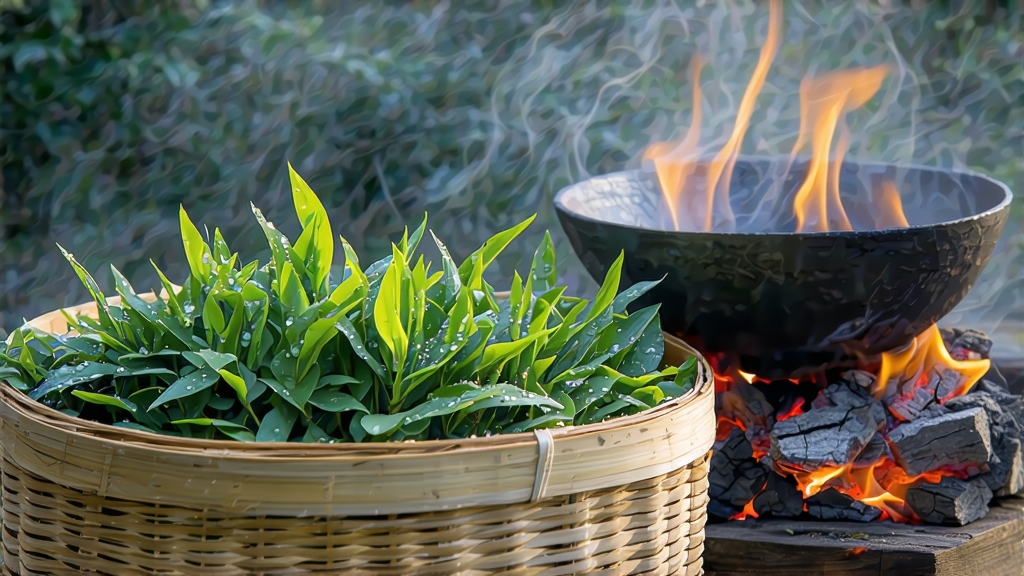
Longjing, literally “Dragon-Well,” is more than a green tea; it is a liquid manuscript of Chinese aesthetics, geography and etiquette. First recorded in Tang dynasty gazetteers but canonized during the Qing Qianlong Emperor’s southern tours, the tea owes its fame to Hangzhou’s West Lake, whose microclimate of mild winters, misty springs and quartz-rich sandstones endows the leaf with an unmistakable “orchid-almond” fragrance. Legend claims that Qianlong himself bestowed imperial status on the eighteen bushes still growing beside the Lion Peak, yet the real story is subtler: over nine centuries, monks, scholars and merchants refined both horticulture and ritual until Longjing became the benchmark for all Chinese green teas.
Botanically, Longjing is overwhelmingly the Hangzhou cultivar Camellia sinensis var. sinensis ‘Shuixian’ (literally “narcissus”), selected for its early budding, low tannin and high amino-acid ratio. Within the 168 km² West Lake Designated Origin, four micro-zones are legally recognised: Lion (Shi), Dragon (Long), Cloud (Yun) and Tiger (Hu). Each hill faces southeast, capturing morning sun filtered through humid lake air, but differs in soil depth and diurnal temperature swing, yielding leaf that the trade encodes in four Chinese characters: 香 (fragrance), 醇 (mellowness), 甘 (sweetness), 鲜 (umami). Connoisseurs prize Shi the most for its chestnut note, yet Yun offers a brighter, almost citrus finish. Outside this core, “Zhejiang Longjing” from counties like Xinchang or淳安 may share the shaping technique but lacks the quartz minerality, so the flavour arrives flatter, more astringent.
Craft begins in the field. Picking occurs between Qingming (early April) and Grain Rain (late April), when two leaves and a bud measure exactly 2.5 cm. Experienced pluckers snap the shoot with a faint “pop” that signals the stem is still tender; anything longer will lignify during firing. The day’s harvest must reach the village workshop within two hours, because enzymatic oxidation waits for no poet. There, 250 g of fresh leaf—called qingke—is cooled on bamboo trays for four hours, reducing surface moisture from 75 % to 62 %, a step locals poeticise as “letting the mountain mist return to the sky.”
Pan-firing (shaqing) is Longjing’s signature theatre. A cast-iron wok is pre-heated to 180 °C, then brushed with tea-seed oil and a fistful of fresh leaves that act as seasoning for the season. The master—almost always a woman whose forearms are roped with muscle memory—lowers the temperature to 80 °C within ninety seconds, meanwhile pressing, shaking, rubbing and tossing the leaf in rhythms dictated by a mental metronome: ten quick flicks to drive off steam, five slow presses to flatten the blade, a final upward toss to cool. Each batch lasts twenty-five minutes, after which the leaf has lost 60 % of its weight and acquired the jade-green, spear-flat profile that Tang dynasty poets likened to “a sparrow’s tongue pressed between jade tablets.” The work is so strenuous that a single master can finish only 1.2 kg of finished tea per day, which partly explains top-grade prices exceeding 2 000 USD per kilogram.
After primary firing, the leaf rests for forty minutes, allowing residual heat to homogenise moisture. A second, gentler firing at 60 °C follows, reducing water activity to 3 %—low enough to forbid microbial life yet high enough to preserve the emerald chromophore. Traditionally, charcoal embers buried in ash provide the heat, imparting a faint sweet-smoke nuance; modern factories opt for electric ovens calibrated to mimic the charcoal curve within ±2 °C. The finished tea is sorted by eye: discoloured leaves, fragments and stems are lifted away with bamboo tweezers in a ritual called tiao ji, “picking the chicken feathers from the phoenix.”
Storage is the invisible half of craftsmanship. The tea is packed in lime-lined earthen jars whose alkaline micro-environment scavenges carbon dioxide, effectively freezing the aromatic clock. Merchants in Hangzhou still follow the Ming dynasty rule: “three parts tea, seven parts storage.” When done correctly, pre-Qing